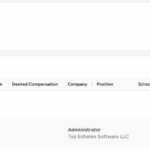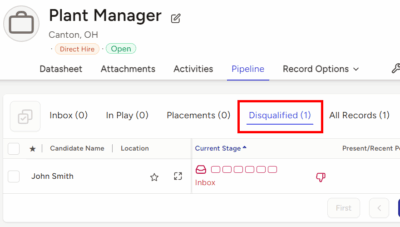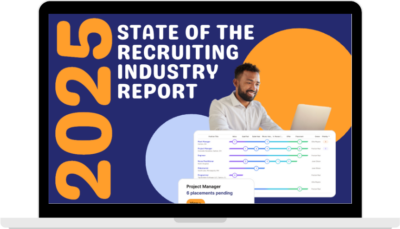Ah, yes . . . technology.
Technology promises to make everything easier, faster, and smarter. But ask any agency recruiter about their daily experience, and you might hear a different story—one filled with frustration, tool overload, and fear of switching platforms.
To better understand what recruiters really think about their tech stacks, we surveyed agency recruiters and search consultants currently working in the profession. Their answers shed light on a growing challenge we call “Tech Fatigue,” which is the disconnect between what recruiting software should do and how it actually performs in the trenches.
Let’s break down the key findings and what they mean for recruiters trying to balance efficiency, ROI, and sanity.
The State of ATS Satisfaction: Good—But Not Great
We began with a simple question: “On a scale from 1 to 5, how would you rate your current applicant tracking system or recruiting software?”
Here’s how the 239 respondents rated their current systems:
- 1 (Very Dissatisfied): 3.35%
- 2 (Dissatisfied): 8.37%
- 3 (Neutral): 22.59%
- 4 (Satisfied): 45.19%
- 5 (Very Satisfied): 20.50%
On the surface, that’s not bad; nearly two-thirds (65.69%) gave their system a 4 or 5. But dig a little deeper, and you’ll see a system that’s “fine” for most, but far from ideal.
Only 1 in 5 recruiters feel their ATS is excellent.
Meanwhile, over a third of users gave their systems a rating of 3 or lower, reflecting either ambivalence or dissatisfaction.
What Recruiters Like About Their Systems
When asked what they liked most about their current ATS, some common themes emerged:
- Cloud-based accessibility
- Ease of use and user-friendliness
- Integration with job boards and payroll systems
- “One-stop” job posting capabilities
- Ongoing updates and customizability
Many respondents praised the flexibility and automation that modern systems bring to the table, particularly when they integrate seamlessly with back-office operations.
One user highlighted:
“It’s online and available anywhere I am.”
Another noted:
“I like the constant upgrades.”
But this surface-level convenience often comes at a cost.
What Recruiters Dislike About Their Systems
When we asked about dislikes, the responses were more specific—and more pointed. Among the most common complaints:
- Clunky or outdated user interface
- Too many clicks to complete simple tasks
- Lack of automation or AI features
- No mobile app
- Hidden costs and upcharges
- Poor reporting functionality
- Weak customer support
One recruiter summarized it well:
“It takes multiple clicks to do the same thing in Ceipal as in our old system.”
Another added:
“Additional charges for the good features/tools.”
It’s clear that while some systems look good on paper, the day-to-day user experience doesn’t always deliver on expectations.
What’s Missing: The Features Recruiters Want Most
We then asked: What functionality do you wish your ATS had but doesn’t?
The top wish list items included:
- AI-driven recommendations
- Mobile apps
- Automation of admin tasks
- Integrated email and calendar
- Better front-end UX
- Real-time analytics and reporting
Several recruiters voiced frustration with poor data migration from legacy systems and lack of customizability.
One response cut to the chase:
“Trying to determine the right stack, which integrates well, etc.”
In short, many systems work—but they don’t work together.
Tech Fatigue is Real and It’s Widespread
One of the most revealing questions in the survey was:
“How often do you feel overwhelmed by the number of recruiting tools, platforms, and logins you use daily?”
The results speak for themselves:
- Always: 24.27%
- Often: 30.13%
- Occasionally: 31.38%
- Rarely: 14.23%
That means over 85% of recruiters experience tech fatigue at least occasionally—and over half say it happens often or always.
The culprit? A fragmented tech ecosystem that demands constant juggling of tools, tabs, and passwords.
Top Tech Frustrations: Integration, Switching, and Support
When asked what causes the most frustration with recruiting tech, respondents could choose multiple options. Here’s what topped the list:
- Too many tools that don’t integrate (57.3%)
- Time spent switching between platforms (56.5%)
- Learning curves with new systems (55.2%)
- Poor customer support (29.3%)
- Feature overload (26.3%)
- Lack of ROI clarity (23.4%)
This paints a picture of an industry overwhelmed by tool sprawl, training fatigue, and unclear value.
Even systems with the “right” features often fail due to poor user experience or weak onboarding.
The Cost of Switching: Tech Fatigue Creates Inertia
With so many frustrations, you’d think more firms would be racing to switch platforms. But here’s the catch:
67.36% said they’ve delayed switching software because of tech fatigue.
Even when recruiters know their system isn’t working, they’re often too burned out—or too skeptical—to make a change.
Why? Because switching comes with its own fears:
- Implementation time (61.1%)
- Cost (57.3%)
- Hidden limitations (54.4%)
- Poor user experience (52.7%)
- Data loss (35.6%)
The bottom line: frustration keeps them stuck, but fear prevents escape.
Mixed Emotions Toward New Tech: Hopeful But Hesitant
Recruiters feel a mix of emotions about adopting new recruiting technology:
- Curious (49.8%)
- Skeptical (41%)
- Excited (39.3%)
- Exhausted (31.8%)
- Hopeful (36%)
- Resigned (10.9%)
These responses show that while there’s interest in new solutions, there’s also fatigue and fear. Any vendor or platform hoping to win over recruiters today needs to demonstrate clear value, minimal disruption, and easy onboarding.
What Recruiters Wish They Could Fix
We closed the survey with a simple, powerful prompt:
“If you could wave a magic wand and fix one thing about your recruiting tech stack, what would it be?”
The answers revealed a few key themes:
- Simplification: A streamlined, intuitive platform with fewer logins and more automation.
- Better Integration: Between ATS, email, calendar, CRM, job boards, and reporting tools.
- Mobile Accessibility: A true mobile app that mirrors desktop functionality.
- Real-Time Data: Fast, reliable analytics for smarter decisions.
- End-to-End Visibility: From candidate sourcing to placement, all in one view.
One recruiter summed it up perfectly:
“Complete integration.”
Another offered this wish:
“An intuitive, user-friendly calendar with daily to-do list and agenda.”
Looking Ahead: Are Recruiters Ready to Switch?
Finally, we asked:
“Is your organization planning to switch its applicant tracking system or recruiting software within the next 12 months?”
Here’s what we found:
- Yes, absolutely: 27.6%
- Maybe: 25.9%
- Highly unlikely: 28.9%
- Hard no: 17.6%
Roughly 1 in 2 respondents are at least open to switching, despite the fatigue and fear. That represents an opportunity for platforms to step up with solutions that ease the burden—not add to it.
What This Means for Recruiting Teams and Tech Vendors
For recruiting firms, this data is a clear signal:
Your tech stack might be holding your team back. Even if you’re “satisfied,” ask whether your current platform is driving real efficiency and ROI—or just barely keeping up.
For tech vendors, the message is just as urgent:
Make your product easy to use, fast to implement, mobile-friendly, and fully integrated. Prioritize customer support. And above all—deliver value fast.
Because the truth is, recruiters want to do what they do best: build relationships, not wrangle tools.
Tech Should Empower, NOT Exhaust
Recruiters didn’t enter this industry to manage software—they entered it to make connections, solve problems, and change lives.
If your recruiting tech stack leaves your team overwhelmed, frustrated, or stuck… it might be time to stop tolerating “good enough” and start looking for “great.”
Because when tech gets out of the way, recruiters can get back to doing what matters most.









